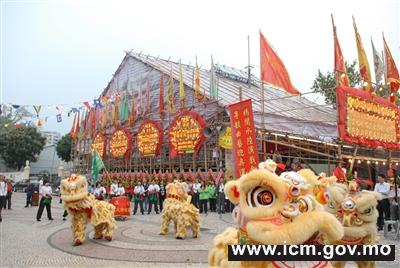“A-Ma Belief and Customs” and “Na Tcha Belief and Customs” have been included in the fourth batch of the National List of Intangible Cultural Heritage Representative Items. The List was announced by the PRC’s State Council.
In September 2013, the Chinese Ministry of Culture began works related to the fourth batch of the National List of Intangible Cultural Heritage Representative Items. Applications of two groups related to the above mentioned beliefs and customs relied on the support and assistance of the Cultural Affairs Bureau (IC, from the Portuguese acronym), and were submitted to the Ministry of Culture at the end of November 2013. The items chosen embody important traditional culture in Macao and are representative of folk festivities.
“A-Ma Belief and Customs” boast a long history and are one of the most important local beliefs. Throughout the centuries, Macao inhabitants lived off fishing and external trade, facing the dangers of the sea. They believed this goddess protected them against those dangers, granting them peace and fortune, and thus becoming their protector. This lead to the construction of temples and the development of beliefs in A-Ma’s honour. The Chinese population of Macao started bringing different worship forms of A-Ma into their daily lives. Annually, a few days before the A-Ma Festival, held on the 23rd day of the 3rd month of the lunar calendar, the population organises a series of activities in temples dedicated to A-Ma and in front of these temples, such as worship, offerings, games and auctions. These beliefs and customs have become an important tradition within the Chinese community, and they have been transmitted and developed throughout the centuries. Likewise, these customs and beliefs are an important witness to the promotion and transmission of the Chinese folk culture in Macao.
“Na Tcha Belief and Customs” are a local characteristic and have existed for over 300 years. Annually, on the 18th day of the 5th month of the lunar calendar, the Na Tcha festivities are celebrated with the purpose to ask for protection against diseases and for the harmony of society. Temples dedicated to this deity organise worship ceremonies, the construction of altars, parades and Chinese opera, among others. This belief is intended not only to attain social recognition but also to improve community cohesion and promote traditional culture, boasting important cultural values and local characteristics. Within the framework of the national policies of protection of intangible cultural heritage, both temples dedicated to Na Tcha have declared praiseworthy intentions to reflect the harmonious cultural fusion and to contribute towards the protection of local traditional culture.
The State Council announced, in 2006, 2008, 2011 and 2014, a grand total of 1372 representative items of national intangible cultural heritage. According to the PRC’s Intangible Cultural Heritage Law, the National List of Intangible Cultural Heritage will be henceforth known as the National List of Intangible Cultural Heritage Representative Items. Macao has of now eight items on this list, namely Yueju Opera and Herbal Tea – inscribed by joint application of Macao, Guangdong and Hong Kong; and Woodwork – Macao Religious Figure Carving, Taoist Ritual Music in Macao, Feast of the Drunken Dragon, Cantonese Naamyam, and the most recent A-Ma Belief and Customs and Na Tcha Belief and Customs - inscribed by independent application of Macao.
The success of these applications reveals the diversity and richness of Macao’s intangible cultural heritage. The successful application process was the result of the cooperation of governmental departments, civil entities, experts and academics. In the future, IC will continue to recognize, archive, survey and research Macao’s intangible cultural heritage so that even more local cultural traditions with historical value can be protected and promoted.

